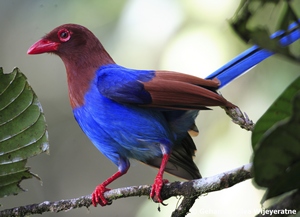Sinharaja Rainforest in Sri Lanka
The Sinharaja Bird Waves are the longest studied, largest in the world and offer the best viewing. 29 of the island’s 33 endemics have been recorded here making it an ‘endemic birdng hotspot’.
The Sinharaja Man and Biosphere Reserve was declared a World Heritage Site in 1988. It is arguably the most important biodiversity site in Sri Lanka and is also internationally important for tropical biodiversity.
Wildlife Sinharaja comprises of lowland and sub-montane wet evergreen forests with sub-montane Patana grasslands in the east. A staggering 64% of the tree species are endemic to Sri Lanka. The lower slopes and valleys have remnant Dipterocarpus forest with the middle and higher slopes characterised by trees of the genus Mesua. Orchids and pitcher plants are common in nutrient poor soils.
Getting There
Wild Life
Endemic birds include the Ceylon Spurfowl, Ceylon Junglefowl, Ceylon Wood Pigeon, Ceylon Hanging Parrot, Layard’s Parakeet, Red-faced Malkoha, Green-billed Coucal, Serendib Scops Owl, Chestnut-backed Owlet, Ceylon Grey Hornbill, Yellow-fronted Barbet, Ceylon Small Barbet, Crimson-backed Flameback, Black-capped Bulbul, Spot-winged Thrush, Ceylon Rufous and Brown-capped Babblers, Ashy-headed Laughingthrush, Ceylon Blue Magpie, White-faced Starling, Ceylon Hill- Myna, Ceylon Scaly Thrush, Ceylon Scimitar Babbler and Ceylon Crested Drongo. Indian sub-continental endemics include Malabar Trogon and Ceylon Frogmouth.
Half of Sri Lanka’s endemic mammals and butterflies are found here. Visitors are more likely to see Purple-faced Leaf Monkey and Grizzled Indian Squirrel. Endemic lizards include the endangered Whistling Lizard and Rough-nosed Horned Lizard.
Park Accomodations
Boulder Garden at Kalawana is the nearest star quality accommodation. Serious birders can look at Martin’s and Blue Magpie Lodge, near the reserve.
Source: Sri Lanka National Parks & Reserves by Gehan de Silva Wijeyeratne, published by Jetwing Eco Holidays.











